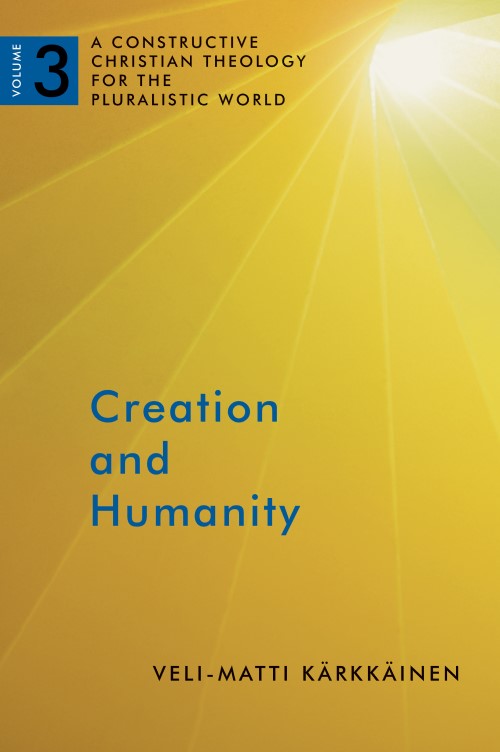Veli-Matti Karkkainen: Creation and Humanity
 Veli-Matti Kärkkäinen, Creation and Humanity, A Constructive Christian Theology for the Pluralistic World, Volume 3 (Grand Rapids: William B. Eerdmans, 2015), pages x+554.
Veli-Matti Kärkkäinen, Creation and Humanity, A Constructive Christian Theology for the Pluralistic World, Volume 3 (Grand Rapids: William B. Eerdmans, 2015), pages x+554.
As a constructive theologian, Kärkkäinen works to create a coherent explanation of religious belief (in this case, Christian) by honest engagement with a variety of voices, including Christian (i.e. Catholic, Eastern Orthodox, third-world, feminist, Evangelical etc.), non-Christian (Jewish, Muslim, Hindu, and Buddhist), and scientific. In this sense, Kärkkäinen’s work is non-foundational and non-dogmatic. He says, citing Pannenberg’s Systematic Theology that, “…theology, must check the “correspondence” of its statements with both inner and external statements.” (p.3.) This text is Kärkkäinen’s third of five installments in the development of that coherent theology.
The book divides into two main parts. Part 1 discusses creation and Part 2 covers humanity. Discussion of angelic beings, demonic and sacred are not addressed in this volume. Kärkkäinen, like many Christians, believes that the historic Christian view of Creation requires reappraisal both to correct the Church’s reliance on dualism (body/spirit; secular/sacred; p.9), and to respond to the pending environmental collapse and the findings of science (p.10). After orienting the reader to his approach, Kärkkäinen discusses how science and theology should relate. In his usual way, Kärkkäinen engages the subject by explaining how various religious faiths relate to scientific inquiry. As mentioned in my reviews of earlier volumes, Kärkkäinen faithfully describes various belief systems and avoids caricatures or straw men. Readers will frequently find his rubrics to be helpful in articulating and categorizing various viewpoints. For instance, his review of the different types of scientific naturalism in Chapter 2 and perspectives on nature in Chapter 3 are particularly instructive. While this reviewer believes that Kärkkäinen can be too generous with his interlocutors, readers can be assured that when he does criticize a viewpoint, his criticisms will be well founded.
When Kärkkäinen does criticize a viewpoint, his criticisms will be well founded.
Second, the author appears to accept the truth of evolution as a given. Therefore, he is obligated to spend a great deal of ink exploring ways to harmonize creation (theology) and evolution (science). This reviewer appreciated Kärkkäinen’s commitment to a divine purpose and action in creation as well as his thoughts on understanding divine action without falling into determinism (Chapters 6-7). On the downside, Kärkkäinen’s readiness to modify classical beliefs, such as God’s timelessness (pp.129ff), is troubling and indicates an excessive willingness to be swayed by contemporary winds.
In Part 2, Humanity, Kärkkäinen’s acceptance of evolutionary theory means that he must find a way to discuss humanity’s beginning, transmission of sin, and nature that accords with Scripture and science. He holds to a dynamic understanding of the “image of God” by emphasizing its social and communal nature, while not denying essentialist ideas.


